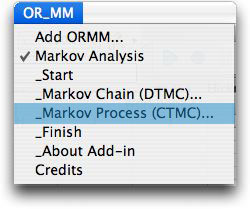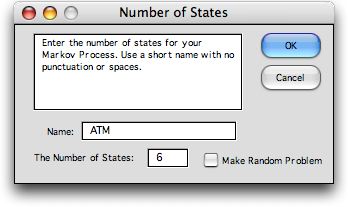|
|

|
Selecting the Markov Process
item under Markov Analysis, provides the opportunity to
construct a Markov Process Model. We describe below the various
analyses possible for the example which is described below.
All the analyses available for the Markov Chain's are also
available for the Markov Process. Since the Markov Process
is a continuous time model, there is some expansion of the
analyses. Both are implemented by the same add-in, the Markov
Analysis add-in (stoch_anal.xla).
When the Markov Process item is selected the dialog
below is presented.

The dialog accepts a name for the model and the
number of states. When the Make Random Problem checkbox
is checked. A random problem is generated. |
| |
To illustrate the
elements of the Markov process model, we use the example
of a single Automated Teller Machine (ATM) located in foyer
of a bank. The ATM performs banking operations for people arriving
for service. The machine is used by only one person at a time,
and that person said to be in service. Others arriving
when the machine is busy must wait in a single queue, and these
people are said to be in the queue. Following the rule
of first-come-first-served, a person in the queue will
eventually enter service and will ultimately leave the system.
The number in the system is the total of the number
in service plus the number in the queue. The foyer is limited
in size so that it can hold only five people. Since the weather
is generally bad in this part of the country, when the foyer
is full, arriving people do not enter. We have gathered statistics
on ATM usage that show the time between arrivals averages 30
seconds (or 0.5 minutes). The time for service averages 24
seconds (or 0.4 minutes). Although the ATM has sufficient capacity
to meet all demand, we frequently observe queues at the machine
and occasionally customers are lost.
We want to perform an analysis to determine statistical measures
that describe the number of people in the system, the waiting
time for customers, the efficiency of the ATM machine, and
the number of customers not served because there is no room
in the foyer. We intend to use these statistics to guide managers
in design questions such as whether another ATM should be installed,
or whether the size of the foyer should be expanded. |



